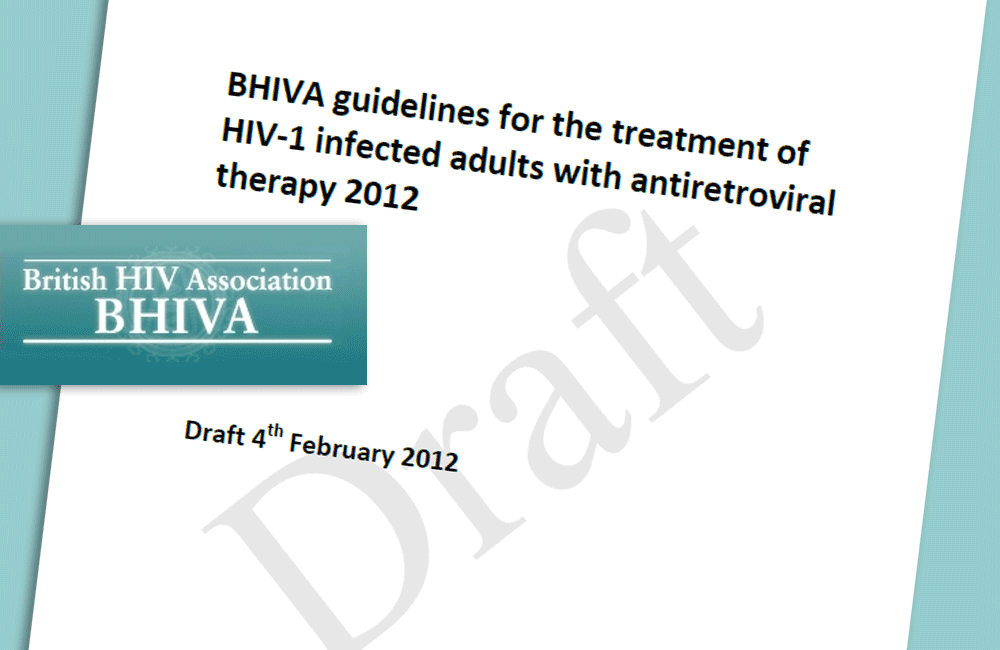
The British HIV Association (BHIVA) today recommends that doctors should discuss the evidence for the effectiveness of antiretroviral treatment as prevention with all patients with HIV, and that it should be offered those who want to protect their partners from the risk of HIV infection – even if they have no immediate clinical need for treatment themselves.
Evidence from a large trial of the effects of earlier antiretroviral treatment on HIV transmission to partners has convinced UK doctors that treatment should be offered in circumstances where patients are concerned about the risk of transmitting HIV to partners – even if they are not in a serodiscordant relationship at the time.
All patients should be informed of this evidence, the guidelines say, but no patient should be forced to take treatment for this reason.
Patients should also be told that the evidence of a lower risk of transmission on treatment mainly relates to vaginal sex, not anal sex, and that use of condoms will continue to protect against sexually transmitted infections as well as lowering any residual risk of HIV transmission.
The recommendation forms part of new adult antiretroviral treatment guidelines for the United Kingdom issued for consultation this week.
After rigorous review of the published evidence, British doctors have concluded that the UK will stick with a CD4 cell count of 350 cells as the threshold for starting treatment in the majority of patients.
In contrast, United States guidelines recommend treatment in patients with CD4 counts up to 500 cells, though noting the absence of evidence from randomised trials to support this guidance.
The new UK guidelines also make a clear recommendation on the two nucleoside drugs that should be used as the basis of first-line antiretroviral treatment. The guidelines committee has concluded that the balance of evidence favours tenofovir and emtricitabine (FTC), combined in Truvada, as the preferred option for patients in the UK.
Key changes
When to start
Although BHIVA continues to recommend that people start treatment at a CD4 cell count of 350 or below, the guidelines also recommend that doctors should discuss the evidence that treatment reduces the risk of HIV transmission to partners with patients who have CD4 counts above 350. If patients want to start treatment to reduce the risk of transmitting HIV to a partner they should be allowed to do so.
Treatment is also recommended in the following circumstances in patients with CD4 counts above 350:
- Any AIDS-defining illness
- HIV-related comorbidity such as HIV-associated nephropathy (kidney disease) or neurocognitive disorder
- Co-infection with hepatitis B or hepatitis C if the CD4 cell count is below 500 (antiretroviral therapy should be started if the patient is already taking hepatitis C therapy, rather than waiting for completion of hepatitis C treatment).
- Tuberculosis, if the physician thinks antiretroviral treatment is needed
- Non-AIDS cancers requiring immunosuppressive chemotherapy or radiotherapy, including cervical cancer.
In cases of primary infection, treatment is recommended if the patient has any neurological symptoms, any AIDS-defining illness or a CD4 cell count below 350. Treatment is recommended regardless (even if none of these criteria apply) in cases where the interval since presumed infection is less than 12 weeks, or where the patient wants to start treatment in order to reduce the risk of transmission.
What to start with
BHIVA recommends that people start treatment with a combination based on tenofovir and emtricitabine (FTC) (Truvada, also coformulated with efavirenz as Atripla or with rilpivirine as Eviplera).
Abacavir and 3TC-based (Kivexa) treatment may be used as an alternative, but should be avoided in patients at risk for hypersensitivity (HLA B*5701), those with baseline viral load above 100,000 copies/ml and those with high cardiovascular risk.
In 2008, BHIVA recommended that either tenofovir/FTC or abacavir/3TC be used as the 'preferred' NRTI backbone. In 2009, an addendum to the guidelines expressed the need for caution in the use of abacavir, following the presentation of data showing an increased risk of cardiovascular disease in patients takling abacavir.
The decision to recommend tenofovir-based treatment in the 2012 guidelines is primarily based on consideration of virologic outcomes at 96 weeks, rather than on safety.
The preferred third agent is efavirenz (Sustiva), raltegravir (Isentress), or either atazanavir (Reyataz) or darunavir (Prezista) boosted by ritonavir. Previously the British HIV Association had recommended efavirenz as the only 'preferred' option.
The expansion in the number of third agents now recommended, compared with the 2008 guidelines (which recommended efavirenz), comes as a result of comparisons between data from clinical trials on the basis of virological outcomes, resistance and safety.
Lopinavir/ritonavir (Kaletra) is an acceptable alternative to any of these drugs if none prove suitable, as is fosamprenavir /ritonavir (Telzir). Nevirapine may be used, but only in men with CD4 counts below 400 and women with CD4 counts below 250. Rilpivirine (Edurant) should be used only in patients with baseline viral loads below 100,000 copies/ml.
Disclosure
Gus Cairns of NAM served as a community representative on the BHIVA adult antiretroviral treatment guidelines writing committee. (He's written about this in HIV treatment update, which you can read online here: www.aidsmap.com/Treatment-what-really-works-best/page/2232680/)
Consultation now open
The draft guidelines are available for download from the BHIVA website. Consultation on the draft guidelines is now open, and will run until 5 March 2012.
